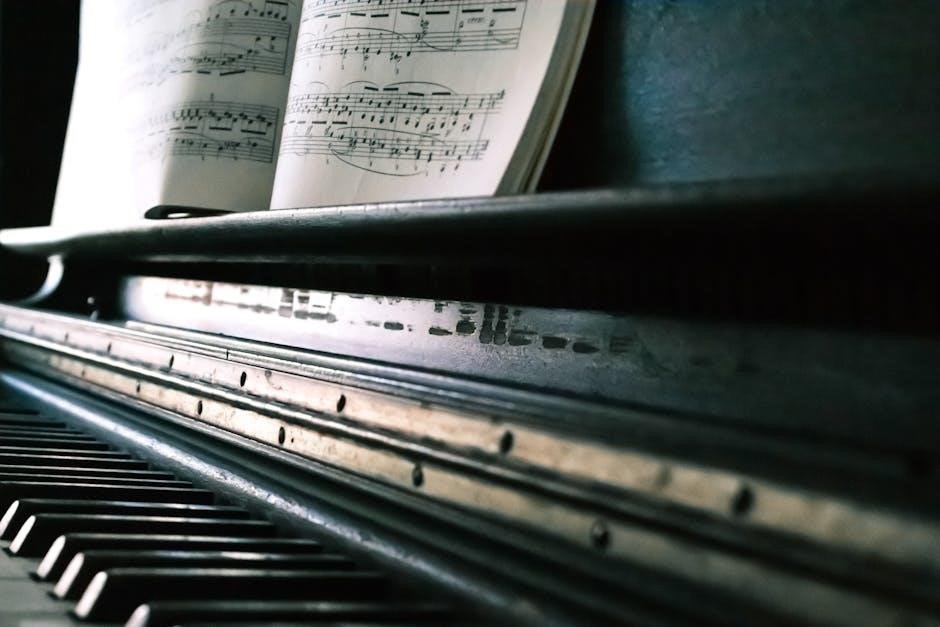
carol of the bells piano sheet music pdf free
“Carol of the Bells” is a classical composition by Mykola Leontovych, based on a Ukrainian folk song. It was created for choir in 1916 and has since become a popular Christmas carol. The piece is known for its hauntingly beautiful melody and rhythmic complexity, making it a favorite for various arrangements, including piano versions. Its enduring appeal lies in its ability to evoke a sense of celebration and nostalgia, transcending cultural boundaries through its universal musical language;
1.1 What is “Carol of the Bells”?
“Carol of the Bells” is a renowned musical composition by Mykola Leontovych, based on a traditional Ukrainian folk chant. Originally composed in 1916 for a cappella choir, it was later adapted into a popular Christmas carol. The piece is characterized by its unique, haunting melody and rhythmic bell-like sounds, which create a festive and enchanting atmosphere. Over time, it has been arranged for various instruments, including piano, making it a favorite among musicians and music enthusiasts worldwide. Its versatility and timeless appeal have led to numerous interpretations, from classical performances to modern adaptations, ensuring its enduring presence in musical repertoire.
1.2 Historical Background and Composition
“Carol of the Bells” was composed by Mykola Leontovych in 1916, based on the Ukrainian folk chant “Shchedryk.” Initially created for a cappella choir, it gained global recognition after Peter Wilhousky’s 1936 arrangement as a Christmas carol. The piece features distinctive bell-like sounds and a haunting melody, contributing to its widespread appeal. Its rhythmic complexity and festive tone have made it a favorite for various adaptations, including piano arrangements. While the original version is for choir, the composition’s versatility has led to numerous instrumental interpretations, ensuring its enduring popularity in musical repertoire. This timeless piece continues to captivate audiences with its unique blend of tradition and celebration.

1.3 Popularity and Cultural Impact
“Carol of the Bells” has become a beloved Christmas classic worldwide, celebrated for its haunting melody and rhythmic beauty. Its popularity soared after Peter Wilhousky’s 1936 arrangement, transforming it into a festive carol. The piece has been widely adapted for piano, making it a staple in holiday repertoire. Its versatility allows arrangements ranging from simple melodies for beginners to complex versions for advanced pianists. Featured in films, commercials, and performances, it has cemented its place in popular culture. The song’s enduring appeal lies in its ability to evoke both joy and nostalgia, making it a cherished part of holiday traditions across generations and cultures. Its influence continues to grow, ensuring its lasting legacy in music.

Finding Free Piano Sheet Music
Finding free “Carol of the Bells” piano sheet music is straightforward, with websites like PianoCoda.com offering downloadable PDFs. Many arrangements cater to various skill levels, from beginner to advanced.
2.1 Where to Download “Carol of the Bells” PDF for Free
Several websites offer free “Carol of the Bells” piano sheet music in PDF format. Platforms like PianoCoda.com provide downloadable arrangements for various skill levels. Additionally, sites such as Musicnotes and SheetMusicPlus often feature free or discounted versions, especially during holiday seasons. Some arrangers share their adaptations on personal websites or forums, catering to both beginners and advanced pianists. It’s essential to ensure the sources are reputable to avoid copyright issues. Many of these sites also include MIDI files or playback options to help musicians practice effectively. Always verify the quality and accuracy of the sheet music before downloading to ensure a smooth learning experience.
2.2 Reliable Websites for Free Sheet Music
When searching for free “Carol of the Bells” piano sheet music, rely on trusted websites to ensure quality and legality. PianoCoda.com offers a variety of arrangements, including easy, intermediate, and advanced versions. Musicnotes and SheetMusicPlus provide free or discounted options, especially during holidays. MuseScore is another excellent platform, featuring user-generated arrangements that cater to different skill levels. Additionally, IMSLP (International Music Score Library Project) hosts a vast collection of public-domain and free sheet music. Always verify the credibility of the source to avoid copyright issues and ensure the sheet music is accurate and well-formatted for your needs.
2.3 How to Print and Use the Sheet Music

Once you’ve downloaded the “Carol of the Bells” piano sheet music in PDF format, printing and using it is straightforward. Ensure your printer is set to the correct paper size, typically A4 or letter. Adjust settings for high-quality output to maintain clarity. Open the PDF file using a viewer like Adobe Acrobat and select the print option. Choose the desired layout, such as portrait orientation, to fit the music notation properly. After printing, bind the sheets if necessary for easy handling while playing. Some websites also offer MIDI files for playback, allowing you to listen to the arrangement and practice along. Always ensure the sheet music is free for personal use to comply with copyright policies.

Understanding the Sheet Music
Understanding the sheet music of “Carol of the Bells” involves analyzing its structure, arrangement, and musical elements. The composition is adapted for piano, featuring intricate melodies and harmonies. Key signatures, dynamics, and tempo markings guide interpretation. The PDF formats available range from easy to advanced, catering to pianists of all skill levels. This ensures that musicians can appreciate and perform the piece effectively, maintaining its emotional depth and rhythmic energy.

3.1 Structure and Complexity of the Composition
“Carol of the Bells” is a masterfully arranged piece with a unique structure that blends rhythmic patterns and harmonic layers. The composition, originally written for choir, has been skillfully adapted for piano, maintaining its rhythmic complexity and harmonic richness. The sheet music features key signatures that reflect its Ukrainian folk origins, with dynamics and tempo markings that guide the performer through its dramatic peaks and serene moments. The arrangement’s complexity varies, with versions ranging from simple melodies for beginners to intricate, advanced adaptations. This versatility ensures that pianists of all skill levels can engage with the piece, appreciating its depth and emotional resonance. The interplay of bells-like motifs and choral harmonies adds to its distinctive charm and challenges, making it a rewarding piece to study and perform.
3.2 Key Signatures and Musical Notation
The sheet music for “Carol of the Bells” features key signatures that reflect its origins in Ukrainian folk music. The composition is typically written in minor keys, such as G minor, which contributes to its haunting and festive atmosphere. The musical notation includes dynamic markings like ff (very loud) and pp (very soft), emphasizing the dramatic contrasts in the piece. Tempo markings, such as Allegro, guide the performer to maintain a lively pace. The notation also incorporates rhythmic patterns mimicking the sound of bells, with syncopation and arpeggios adding complexity. Specific instructions, like “Hark, how the bells” and ritardando, further enhance the performance. These elements make the sheet music both challenging and rewarding for pianists.
3.3 Dynamics and Tempo Markings
The sheet music for “Carol of the Bells” includes dynamic markings such as ff (very loud) and pp (very soft), creating dramatic contrasts. Tempo markings like Allegro indicate a lively pace, while rall signals a gradual slowing. These elements enhance the piece’s festive and eerie atmosphere. The notation also features rhythmic patterns mimicking bells, with syncopation and arpeggios adding complexity. Specific instructions, such as “Hark, how the bells” and ritardando, guide the performer. The dynamic and tempo markings require careful interpretation to capture the composition’s emotional depth. Pianists must pay attention to these details to deliver a captivating performance, balancing power and subtlety as the music demands.

Learning to Play “Carol of the Bells”

Mastering “Carol of the Bells” requires patience and practice. Start with slower tempos and focus on hand positioning. Break the piece into sections to build confidence and precision. Use free online tutorials or sheet music guides to refine dynamics and rhythm. Begin with an easy version and gradually move to advanced arrangements. Practice regularly to achieve a polished performance.
4.1 Step-by-Step Tutorial for Beginners
Welcome to this step-by-step guide for learning “Carol of the Bells” on the piano. Start by familiarizing yourself with the sheet music and understanding the structure of the piece. Begin with the right-hand melody, focusing on the iconic bell-like arpeggios. Practice each measure slowly, ensuring accurate finger placement. Once comfortable, introduce the left-hand accompaniment, which provides the harmonic foundation. Start with a slow tempo and gradually increase speed as confidence grows. Break the piece into smaller sections and practice hands separately before combining them. Pay attention to dynamics and articulation to maintain the piece’s eerie yet festive atmosphere. Use a metronome to improve timing and rhythm. With consistent practice, you’ll master this beloved Christmas classic.
4.2 Advanced Techniques and Variations
For advanced pianists, “Carol of the Bells” offers opportunities to showcase technical prowess and artistic expression. Experiment with intricate fingerings and pedaling techniques to enhance the piece’s ethereal quality. Consider incorporating advanced variations, such as chromatic runs or harmonic fills, to add depth and complexity. Dynamics play a crucial role; emphasize dramatic contrasts between pianissimo and fortissimo to highlight the music’s emotional range. Tempo rubato can also be applied to certain sections for a more interpretive performance. Additionally, explore polyrhythmic patterns or syncopation to create a modern twist. Advanced players can also experiment with rearranging the melody into different keys or styles, such as jazz or neoclassical, to personalize the piece while maintaining its timeless essence.
4.3 Practice Tips for Mastery
To master “Carol of the Bells”, start by breaking the piece into manageable sections and practicing each part slowly. Use a metronome to maintain consistent tempo, especially in complex rhythmic passages. Focus on dynamics, emphasizing the contrast between soft and loud sections to create dramatic effects. Practice hands separately before combining them to ensure clarity and precision. Pay attention to pedaling techniques to sustain or mute sounds appropriately. Regularly review recordings of professional performances for inspiration and to refine your interpretation. Incorporate finger exercises to build dexterity for intricate runs and arpeggios. Finally, schedule consistent practice sessions to gradually increase speed and confidence, ensuring a polished and expressive performance.

Legal and Ethical Considerations
Ensure you only use free “Carol of the Bells” sheet music from sources that respect copyright laws. Many arrangements are free for personal use, but commercial use may require permission. Always support composers and arrangers by adhering to licensing terms or donating to creators when possible. This ensures ethical use and promotes continued availability of high-quality sheet music for everyone.
5.1 Copyright and Free Usage Policies
When accessing free “Carol of the Bells” piano sheet music, it’s essential to respect copyright laws. Many arrangements are available under free usage policies for personal use, such as educational purposes or private performances. However, commercial use often requires explicit permission or licensing. Websites offering free downloads typically specify terms of use, ensuring compliance with intellectual property rights. Always verify the source’s licensing agreements to avoid legal issues. Supporting creators through donations or purchases encourages the continued availability of high-quality sheet music. By adhering to these guidelines, you can enjoy “Carol of the Bells” responsibly while promoting fair practices for composers and arrangers.

5.2 Supporting the Creators and Composers
Supporting the creators and composers of “Carol of the Bells” sheet music is crucial for sustaining their work. Many arrangers offer free versions to share their passion, but consider donating or purchasing premium arrangements to show appreciation. Websites like PianoCoda.com provide free downloads but often rely on user support to maintain their services. By contributing financially or sharing their work, you help creators continue producing high-quality music resources. Additionally, purchasing licensed versions ensures compliance with copyright laws and directly benefits the artists. Your support fosters a thriving community of musicians and composers, enabling them to create more beautiful arrangements for everyone to enjoy.